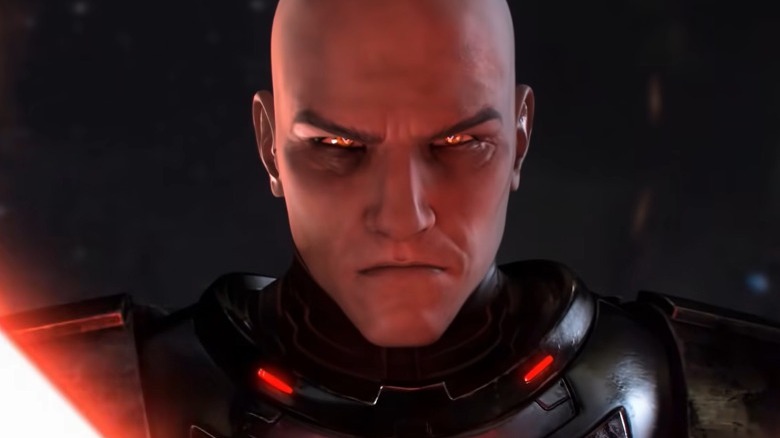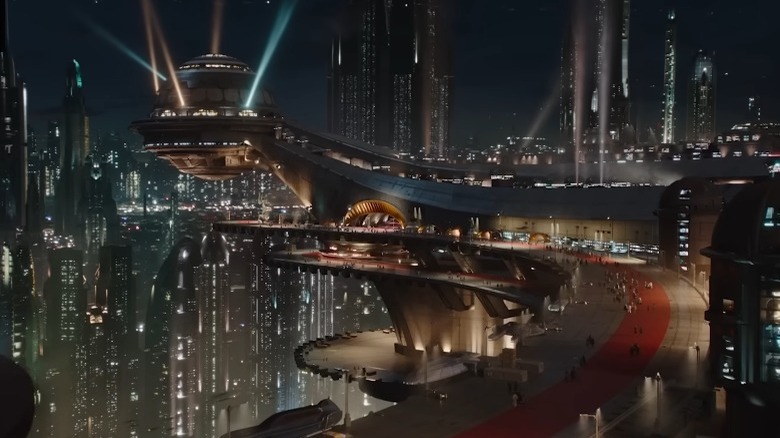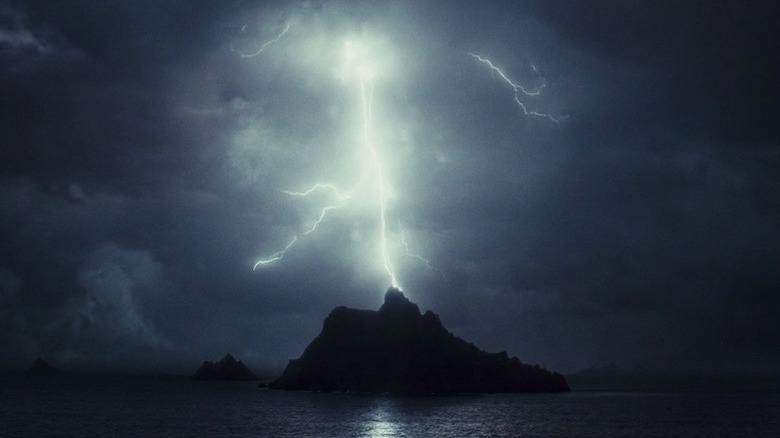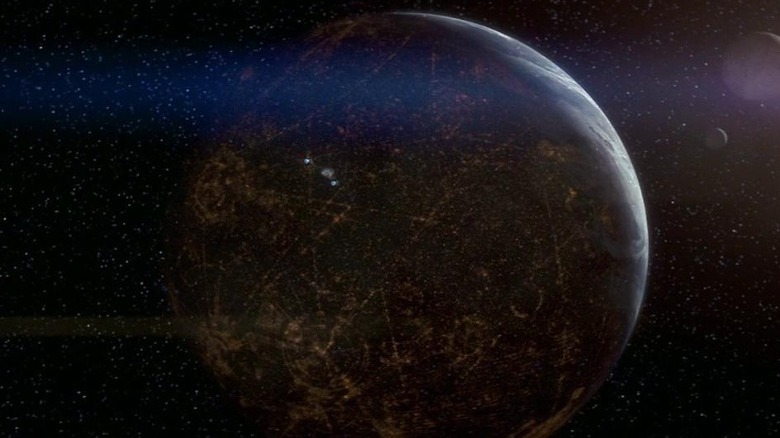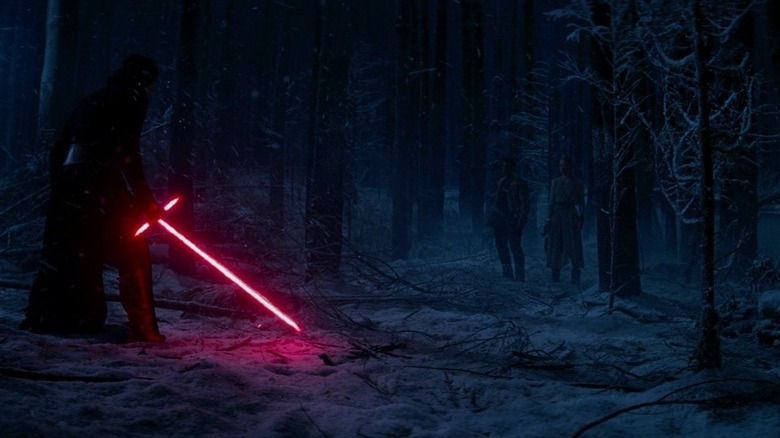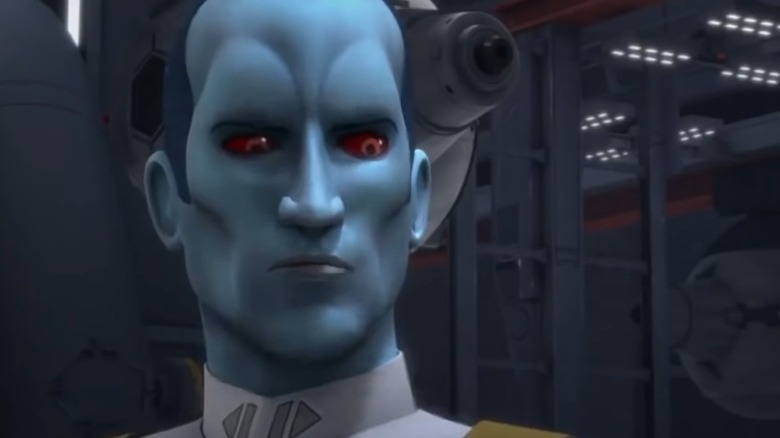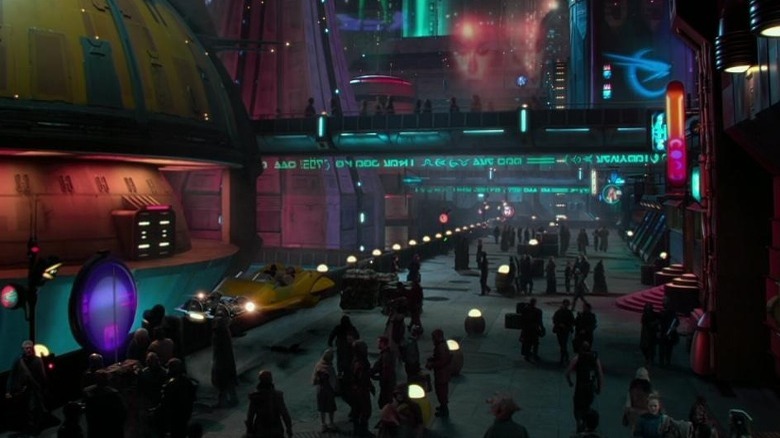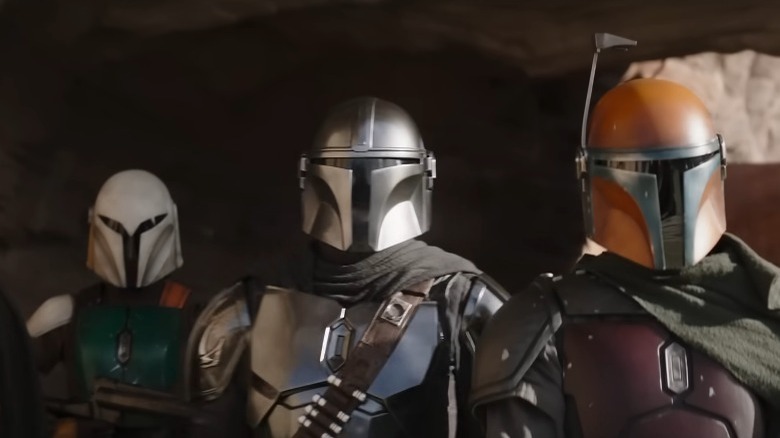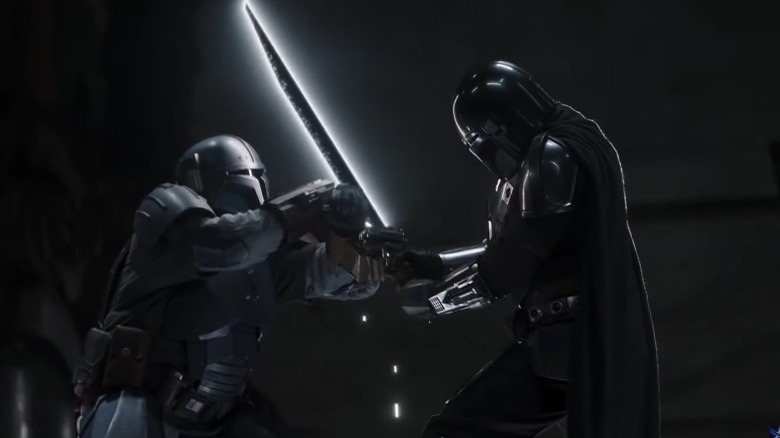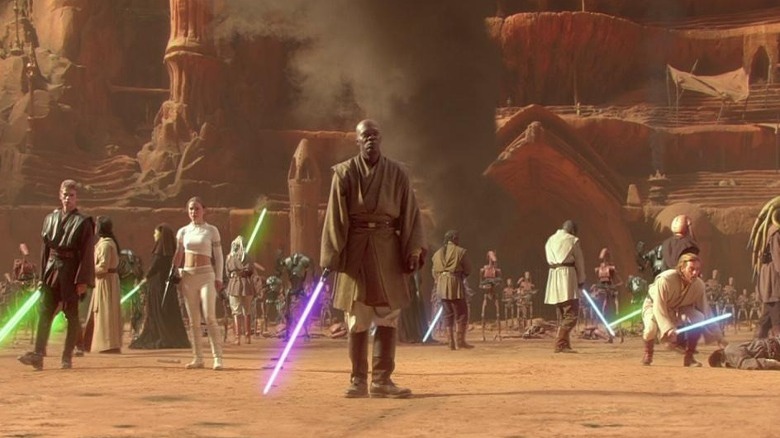The Entire Star Wars Old Republic Era Explained
Audiences first fell in love with the galaxy far, far away decades ago, but the wider "Star Wars" story is longer and more detailed than most moviegoers realize. While every "Star Wars" film amplifies lore and re-defines canon, thus far they have all taken place in one small slice of the galaxy's history. The corruption of Anakin Skywalker, the rise and fall of the Empire, and the Republic's struggle against the First Order all occur over the space of merely a few decades. It begs the question: What happens before and after what we know?
While no one can say with certainty what future stories could unfold for "Star Wars," the franchise's fictional past is seemingly ripe. Before the Empire came to power, the Republic ruled the galaxy for thousands of years, but its position of power was never guaranteed. The Republic grew with the help of the Jedi Order, and their shared history carried the galaxy through multiple historical periods.
As war-torn as the modern era of "Star Wars" has been, it barely holds a candle to the days of the Old Republic. When galactic civilization was still in its infancy, it faced threats from every direction. With another sequel trilogy seemingly on the way, there's never been a better time to dig into the deep "Star Wars" lore that might help shape it. Here's how it all began, in the chaotic days of the Old Republic era.
Formation of the Republic
The Old Republic era began, naturally, with the formation of the Galactic Republic. In the modern "Star Wars" galaxy, time is measured relative to the Battle of Yavin, where Luke Skywalker helped lead the Rebellion to victory against the Empire and its Death Star. The story of the Republic, and by extension the entire galaxy, began some 25,000 years before that decisive victory.
In its earliest days, the Republic was much smaller than the version with which fans of the "Star Wars" movies are familiar, but a number of the planets involved in getting the Republic off the ground will be familiar to any fan of the franchise. Chandrila and Alderaan were among the first members of the Republic, and from the very beginning the Republic made the city planet of Coruscant its primary base of operations.
The Republic would never have risen to power without the support of intricate galactic trade routes. The Corellian Run was one of the earliest established routes, and it became one of the most important trade routes for the entirety of galactic history. When the Corellian Run was first established, it launched the Republic into a period of massive growth — and more-or-less kicked off the beginning of the Old Republic era.
Beginning of the Jedi Order
It just so happens that the Galactic Republic formed around the same time as the Jedi Order. Before the Jedi, there was a group of scholars and monks known as the Dai Bendu. They made it their responsibility to understand and harness a power called the Force that permeated the galaxy. Eventually a Dai Bendu scholar learned how to manipulate the Force and founded the Jedi Order on the planet Ahch-To (where Luke Skywalker would later be seen living in "The Last Jedi").
The Jedi were largely committed to peaceful meditation and quiet contemplation of the Force. The fact that their religious studies came to grant them seemingly magical powers made them semi-mythical figures, even in the days of the Old Republic. As the Galactic Republic began to expand, more and more people throughout the galaxy became aware of the Jedi and their incredible abilities. Eventually, the universe threw a problem at the galaxy that only the Jedi could solve, and that incident cemented the Jedi Order as an important collaborator with the Republic and laid the groundwork for the relationship between both groups, which fans would come to see throughout the prequel trilogy.
Kinro comet incident
In our universe, Earth thankfully hasn't had to face any species-killing galactic threats, but that doesn't mean we aren't getting prepared for them. In September 2022 NASA performed a Double Asteroid Redirection Test (DART) to see if it had the technology to redirect a potential asteroid on a collision course for Earth. The people of the "Star Wars" galaxy, unfortunately, didn't have a similar program running when they came face-to-face with an even bigger threat from deep space.
Thousands of years before the events of the "Star Wars" movies, a comet called Kinro was hurtling toward the heart of the galaxy. If the comet continued on its path, it would tear through the center of the Galactic Republic, potentially destroying multiple planets and billions of lives. The Republic didn't have a high-tech solution to the universe's threat, but it did have the Jedi.
With the comet inching nearer to the galactic core, members of the Jedi order decided it was time to step away from their studies and put their Force abilities to work. With the power of their minds, they managed to tear the Kinro comet apart before it made contact with a single planet. While the effort cost several Jedi their lives, and several more had their minds destroyed, the galaxy was saved, and the Jedi subsequently began to take a more active role in the affairs of the Republic.
The Hundred-Year Darkness
After the Jedi Order saved the galaxy from the Kinro comet, they were hailed as heroes. The Order continued to grow in numbers and deepened its understanding of the Force, but slowly its members began having disagreements about the best ways to use their powers. The Force had such amazing possibilities that some in the Order came to believe they should do more than peacefully study its nature.
In a conflict that later became known as the Hundred-Year Darkness, the Jedi Order split apart, and in a way that schism sealed the galaxy's fate for the next several thousand years. The High Council of the Jedi Order resisted the idea that they should use the most potent abilities, or "dark side," of the Force, and they exiled the Jedi who disagreed with them. Exile didn't stop any Jedi from studying the dark side, however, and over time a new group of students began to take the dark side very seriously. They formed a new order called the Sith and rebelled against the rules of the Jedi Order. It wouldn't take long for the fight between the Jedi and the Sith to engulf the entire galaxy.
Kyber weaponry
The Old Republic era is a part of "Star Wars" history marked by a huge proliferation of dangerous technology that uses kyber crystals. For as long as its been known in the galaxy, kyber has had an association with the Jedi. The crystals were first found by the Jedi on the planet Ilum, and very early on the Order used kyber crystals to power the lightsabers given to its members.
If kyber was exclusively used for lightsabers, it would still be one of the most dangerous substances in the galaxy. Unfortunately, though the Jedi found and used the first kyber on Ilum, that's not the only place where it exists. The Sith found their own supply of kyber crystals and found ways to use them for nefarious purposes.
In "The Big Bang," an unfinished episode of "Star Wars: The Clone Wars," Anakin and Obi-Wan are working to stop General Grievous from getting his hands on a kyber crystal. Along the way, they learn about the existence of kyber-powered superweapons created by the Sith in the Old Republic era. Some of those ancient weapons later informed modern designs like the Death Star, which was itself powered by a kyber crystal.
Rise of the Chiss Ascendency
The Jedi aren't the only ones growing in power throughout the Old Republic era, and the Galactic Republic isn't the only governing body in the universe. The galaxy is big enough for another group to find its way to glory, even if it takes a more isolationist approach to its growth.
Thousands of years before the Battle of Yavin shook the Empire to its core, the Chiss Ascendency was gathering power outside of the known regions of the galaxy. The Ascendency named itself after its dominant species, the blue-skinned humanoid Chiss. Though it formed well before even the Clone Wars, very few people in the Galactic Republic ever knew that the Ascendency existed. It chose to stay on the fringes and kept itself removed from the Republic's galactic wars.
Of course, nothing lasts forever, and eventually the Ascendency did get involved in the rest of the galaxy's affairs. That didn't happen during the Old Republic era, however. The Chiss Ascendency only made itself known after the Empire took over the galaxy, and its first envoy was Thrawn, who would later become a Grand Admiral in the Empire's navy.
Fall of Coruscant
The Hundred-Year Darkness marked the beginning of a new era for the Jedi, and it was dominated by a seemingly endless war. The Jedi and the Sith fought constantly, both in the realm of ideology and in the physical space of the galaxy itself. For a long time the Jedi had the upper hand, but at one point in the age of the Old Republic, they nearly lost everything.
The Sith overcame the Jedi for the first time in a conflict called the Sith War. Finally the Sith had enough power to rival the Galactic Republic, so they launched an assault on the galaxy itself. The fighting impacted just about everyone in the galaxy, but the people of Coruscant were hit the hardest. The Sith managed to capture the planet, and in a way they ruled the galaxy.
While on Coruscant, the Sith constructed a massive shrine honoring the power of the dark side. For as long as the Sith remained in control of the planet, the shrine stood strong. Eventually, the Jedi gained enough strength to drive the Sith away and retake Coruscant. They destroyed the Sith shrine and constructed their own Jedi temple on top of its ruins. Years later, that temple would be the site of the Jedi's collapse, when Anakin betrayed the Order and helped Emperor Palpatine rise to power.
The Mandalorian-Jedi war
During the later years of the Old Republic era, the Jedi found themselves fighting on multiple fronts. They were still battling the Sith when they crossed the path of another group of quasi-religious warriors. The Mandalorians thought of themselves as unparalleled in battle, but their conflict with the Jedi Order would put that reputation to the test.
At the beginning of what would later be called the Mandalorian-Jedi war, it seemed that there could be no contest between the two groups. The Mandalorians had legendary combat proficiency, but there's only so much that physical skill can do in the face of Force abilities and lightsabers. Eventually, the Mandalorians developed their now-iconic armor to help them withstand the Jedi's tools, and the two groups were more evenly matched.
Ultimately, though they were fierce combatants, the Mandalorians weren't able to hold out against the power of the Jedi and the resources of the Galactic Republic. The Mandalorian-Jedi war ended with total devastation on the planet Mandalore. In Season 3 of "The Mandalorian," fans got to see what remains after a more recent assault on the planet that occurred during the Empire's rise to power. Thanks to a long history of warfare, the Mandalorians have become exiles in the galaxy, but the true fate of their people remains to be seen.
Creation of the Darksaber
Not all Mandalorians were completely at odds with the Jedi Order. During the Old Republic era there was one Mandalorian who actually joined the ranks of the Jedi. Tarre Vizla was born a Mandalorian, but at a very young age he showed signs of Force sensitivity. He was brought to the Jedi for training and was eventually inducted into their Order as a Jedi Knight.
As a Jedi Knight, Tarre Vizla had the opportunity to construct a lightsaber for himself. His design married the cultures of the Jedi and the Mandalorians, and it became a legendary weapon in the galaxy. With a hilt of beskar metal and a blade of black energy, Tarre Vizla's signature weapon became known as the Darksaber. Tarre Vizla himself became the leader of the Mandalorians, and his weapon came to signify leadership over their people
After Tarre Vizla's death, the Jedi held onto his lightsaber. The Darksaber resided on Coruscant despite the Mandalorians wanting to keep the weapon for their next leader. As both the Sith and Mandalorian-Jedi wars were raging, Coruscant fell out of the Jedi's control, and the Mandalorians saw their opportunity to reclaim the weapon. Many years later, it would find its way into the hands of Din Djarin during the events of "The Mandalorian" Season 2.
Colonization of Naboo
By now, it should be clear that the Old Republic era was just as war-torn and conflict-driven as the "Star Wars" eras that have made it to the big screen. The Jedi and the Galactic Republic continually found themselves engaged in one battle or another, but despite all the disruption and chaos, the Republic kept expanding its reach across the galaxy. One new addition to the Republic would end up playing a big role in the story of "Star Wars" long after the Old Republic era ended.
Naboo flourished for millennia with an ecosystem perfect for sustaining life. A species called the Gungans became the dominant intelligent life on the planet. Then, about 4,000 years before the Battle of Yavin, a group of human refugees landed on the planet and decided to make it their new home.
For a while, the humans and the Gungans warred with each other, and eventually the Gungans were driven off the planet's land. They established a new society underwater, which is where they're found living during the events of "The Phantom Menace," when a Gungan known as Jar-Jar Binks introduces the Jedi to his people.
Sith defeated
In the closing days of the Sith war, a group called the Brotherhood of Darkness became the last holdout against the Jedi and the Galactic Republic. Even though their numbers were dwindling, the Sith continued to fight, but the pressure began to crack their forces apart. In-fighting amongst the Sith gave the Jedi the last advantage that they needed, and a group of Jedi fighters called the Army of Light finally put an end to the war.
With Coruscant reclaimed and the Sith defeated, the Republic saw nothing but a bright future ahead. To a certain extent, the Republic was right. The end of the war coincides with the end of the Old Republic era in "Star Wars" history. Victorious, the Republic charged forward into a time of prosperity called the High Republic era. The Jedi were able to relax their fighting forces and return to a more contemplative lifestyle, though they continued to play an important role in the Republic's affairs that would continue into the days of the prequel trilogy. The Jedi believed that all the Sith had finally been destroyed — but there was a single survivor from the dark side, and in the closing days of the Old Republic era he began putting the pieces in place that would, centuries later, give rise to the Galactic Empire.
Darth Bane's Grand Plan
When the Sith war ended, the Jedi were victorious, but the Sith weren't completely eradicated. Darth Bane was the last surviving member of their dark order, and he refused to give up the fight. Darth Bane knew that he would not live to see the Sith rise again, but he developed a plan that would one day lead the Sith to galactic conquest.
Darth Bane's first order of business was to establish the Rule of Two. Because in-fighting amongst the Sith had been their ultimate undoing, Darth Bane decided that the Sith should never again grow their ranks as the Jedi had. Going forward, there would always be a Sith master and an apprentice, but the order would never expand beyond that point. Darth Bane hoped that would prevent any significant in-fighting and help the Sith keep a low profile.
Darth Bane needed the Sith to remain quiet and hidden to fulfill what he called the Grand Plan. He believed that the best way to defeat the Jedi and topple the Galactic Republic was to work from the inside. Over a long period of time, the Sith would try to destabilize the Republic and sew seeds for public mistrust of the Jedi. The Grand Plan carried on in the background of Republic life for nearly a thousand years, until Darth Sidius and Anakin Skywalker finally saw Darth Bane's dreams fulfilled.
